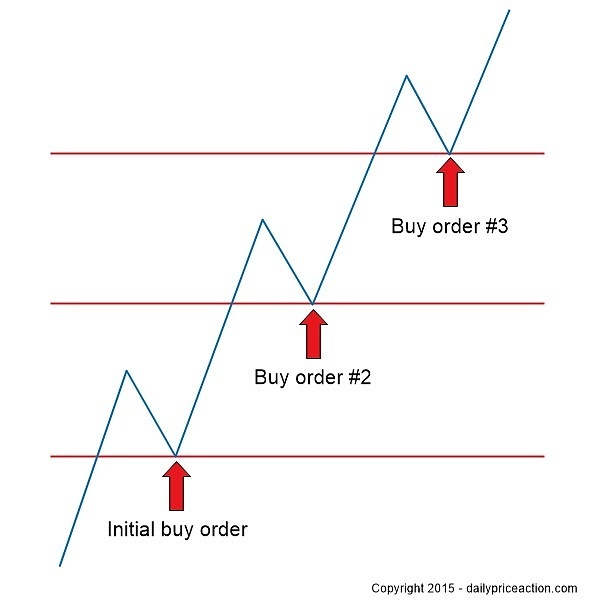Pyramiding
Pyramiding is a traditional trading strategy of increasing a position size by using margin from unrealized gains. Put simply, Pyramiding means that you add to an existing position as soon as price moves in your favor.
A trader who is pyramiding uses additional margin from the increasing price of a security in his or her portfolio to purchase more of the same security. This is generally a slow-moving method of increasing one’s position size, as the margin increases will permit successively smaller purchases.
Pyramid trading fits perfectly into this mentality because it compounds your winning trades into 2 or 3 times the initial profit potential while reducing your overall exposure.
The illustration below shows the basic idea behind pyramiding.
The figure above shows a market that’s in a clear uptrend, making higher highs and higher lows. This is a nice “stair-step” pattern where the market is continuously breaking resistance and then retesting that resistance as new support. Market conditions such as this are perfect for scaling into a winning trade.
The initial buy order in the figure above is triggered when the market retests former resistance as new support. The second and third buy orders are similar to the first, which are both triggered when the market retests a former resistance level as new support.
Remember that the market needs to break through each level and then show signs of holding in order to justify adding to the original position. This is why having a strong trend in place is a requirement for effective pyramiding.
Although in the above figure, the entry point is shown when the resistance-turned-support is re-tested, technically, any good entry point is valid as long as the uptrend is intact. E.g., a volume breakout trader may enter the first position at the breakout of resistance on volume and then subsequent entries could be done at different points in the uptrend whenever there were strong buy signals in the ensuing uptrend.
When to Pyramid
The time to undertake pyramiding is when a market is trending. The idea of the pyramiding strategy is to ride the trend, and this will obviously not apply properly to choppy markets. The retracements experienced in a choppy market will likely put the trade out of the running before it has had a chance to thrive, by triggering the stop loss.
Problems With Pyramiding
Difficulties can arise from pyramiding in markets which have a tendency to “gap” in price from one day to the next. Gaps can cause stops to be blown very easily, revealing the trader to more risk by constantly adding to positions at higher and higher prices. A large gap could mean a very large loss.
Final thoughts on Pyramiding
A significant factor to understand is that it does take some experience to know when pyramiding into a trade may be a good idea and when it’s not. Make sure you keep in mind that the pyramiding strategy is effective in trending markets and will result in greater profits without increasing original risk. In order to prevent increased risk, stops must be continually moved up to recent support levels. Prevent markets that are prone to large gaps in price, and ensure that additional positions and respective stops ensure you will still make profits if the market turns.
